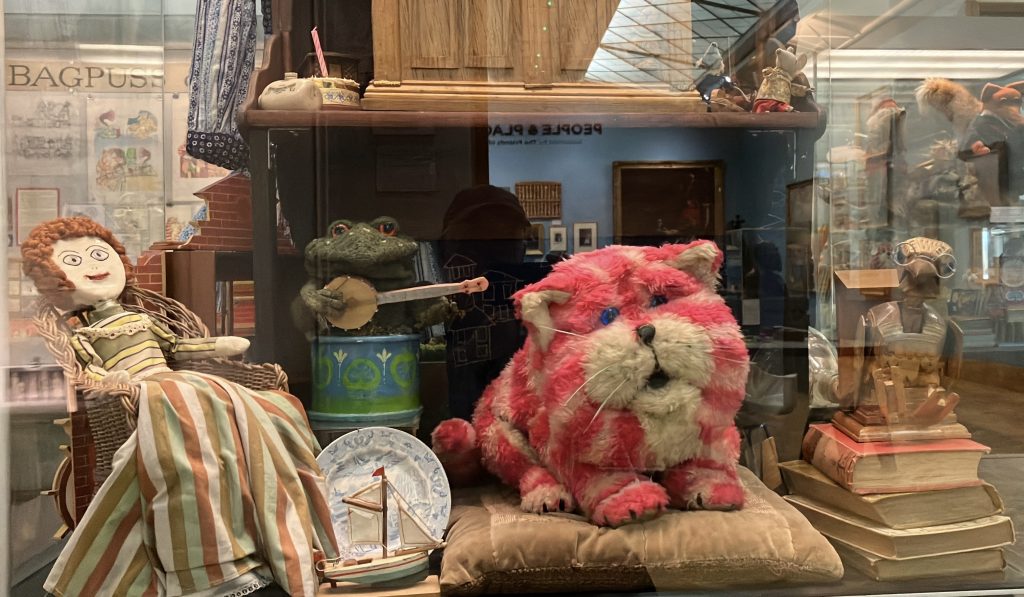Having little interest in the monarchy, I never paid much attention to the long-running Netflix series The Crown until I learned that one of my favourite television characters from my childhood, Bagpuss, appeared briefly in two episodes of Season Four.
In Season Four, Episode Four, Favourites, a heavily pregnant Princess Diana lies in bed at Highgrove House, locking herself away from her abusive husband who is banging at the door, demanding that she come downstairs to meet his mother. She turns to the television, increases the volume on her remote, and settles back to watch Bagpuss and The Frog Princess.
We hear Madeleine the rag doll say that she will sing a song about a “beautiful water princess wearing a tiny silver crown,” and she asks Bagpuss to imagine the scene. We don’t get to hear the rest of the story because there is a cut to outside Highgrove house where the queen is about to arrive. However, Peter Morgan, the show’s creator and writer of that episode, must have known how the story goes and the subversive fairytale plot twist at the end. It gives us a not so subtle hint about Diana’s state of mind.
The water princess, Madeleine tells us, was continually harassed by water lords who wanted to marry her. In order to get rid of all this unwanted attention, she told the water lords that she would throw her crown up into the sky and promised to marry who ever returned it. The water lords all flew up into the air in a vain search for the crown. And, as Madeleine says, you can still see them sometimes, appearing as dragon flies hovering above the water.
Bagpuss thought that could not possibly be the end of the story, so Gabriel, the banjo playing toad, continued the narrative. He explained that the crown was actually swallowed by a frog sitting on a lily pad. Not being the juicy fly he was hoping for, the frog spat it out on to the lily pad. He immediately recognised the crown and dived down to the bottom of the pond to return it to the water princess. She was not pleased to see him because she thought she would now have to marry a frog. But she suddenly remembered that she could transform the frog into a handsome prince with a magic kiss, and proposed. The frog demurred. He was happy being a frog, he said, but offered to kiss the princess instead. She agreed, and became a frog herself. They were married and lived happily ever after.
Diana clearly regretted marrying her prince and probably thought that a common or garden frog might be preferable. Indeed, Diana would go on to kiss quite a few frogs during the disintegration of her marriage.
For those unfamiliar with Bagpuss, the show was created by Oliver Postgate and Peter Firmin at the Smallfilms Animation Studio located in a cowshed just outside Canterbury. For three decades, Smallfilms produced some of British television’s best loved children’s classics, including The Clangers, Ivor the Engine, and Noggin the Nog, but it is Bagpuss, who still holds a special place in our hearts, even 50 years after his first appearance.
There were only 13 short episodes (originally shown between February and May 1974 but regularly repeated) in which Bagpuss and his friends discussed the various objects discovered by Emily (Peter Firmin’s daughter), and created stories about them.
Once upon a time, not so long ago, there was a little girl and her name was Emily, and she had a shop…. It was rather an unusual shop because it didn’t sell anything. You see, everything in that shop window was a thing that somebody had once lost, and Emily had found, and brought home to Bagpuss.
We hear these famous lines, narrated by Oliver Postgate, in Season Four Episode Three of The Crown, entitled Fairytale. Diana, sad and bored, sits alone in her room in Buckingham Palace, sapphire engagement ring prominently displayed on her finger, wistfully watching the opening credits of the show. Three servants march into the room, delivering boxes of correspondence from complete strangers, and ignoring the young woman in the corner.
Diana is shown as a fragile, childlike figure, utterly lost in the cold, hostile world of the royal family. She roller-skates around the empty hallways listening to her Walkman, she binges on food from the pantry and then immediately purges. The one letter from thousands that she chooses to respond to is from a seven-year-old girl.
Like all British children of our generation*, Diana grew up with Bagpuss and understood the magic of that saggy, old, pink and white striped cloth cat. He was gentle and wise, and helped us make sense of a confusing world. It is perfectly understandable then that the 19-year-old Diana (or at least the character version of her) would turn to him for comfort in her hour of need.

If you would like to visit Bagpuss and his friends, they currently reside at the Beaney House of Art and Knowledge in the centre of Canterbury. See photo above. The museum has a permanent exhibition on the upper level dedicated to the history of Smallfilms and all the delightful characters it created.
* Diana Spencer and I were born two weeks apart.